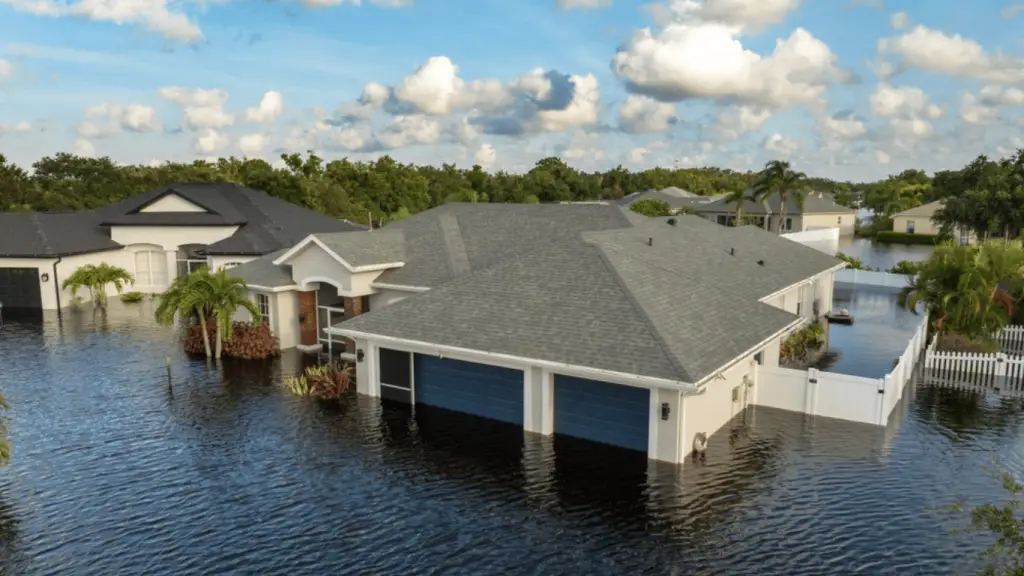[ad_1]
Flood Insurance
FEMA defines a flood as a “general and temporary condition of partial or complete inundation of two or more acres and two or more properties of normally dry land.” In addition, flood damage can only be caused by the “overflow of inland or tidal waters, unusual and rapid accumulation or runoff of surface waters from any source, mudflow, or collapse of land along the shore of a lake or a similar body of water as a result of erosion or undermining caused by waves or currents of water exceeding anticipated cyclical levels.”
A flood may occur when water from natural sources such as rivers and lakes breaches its banks during heavy rains or when the ground is over-saturated with water and causes the excess to seep through foundations or other vulnerable parts of the structure.
Most property policies exclude coverage for “flood, surface water, waves, tides, tidal waves, overflow of any body of water, or their spray, all whether driven by wind or not…” (Insurance Services Office). Thus, flood coverage must be purchased separately. Costs vary and are dependent upon the amount of coverage desired and the property’s location within specified flood zones.
Water Damage Coverage
Water Damage must be “sudden and accidental” to be covered, such as a pipe bursting or the accidental overflow of a bathtub. In colder seasons if freezing causes a pipe to burst, one must certify that they have done their best to maintain heat in the building or have fully drained the system and shut off the water supply in order for coverage to be available for the ensuing water damage. Rain that damages the interior of a property after the roof is compromised from a storm also falls under the category of Water Damage.
The easiest way to ensure you have Water Damage coverage included on your policy is to purchase Special Form Insurance Coverage. Be careful as some carriers can and will manuscript those policies to exclude Water Damage coverage (even when you purchase Special Form). While it is always a best practice to read your full policy, at the very least you should review your policy endorsements and exclusions to make sure this exclusion is not present.
Sewer Back-up Coverage
Sewer Back-up is another common exclusion in property policies and is defined as “water that backs up or overflows from a sewer, drain, or sump.” (ISO) Drains and sewers can back up during storms. So, what you or I call a “flooded basement” may or may not technically be considered a flood when it comes to insurance. It all depends upon how the water enters the dwelling. That stated, investors will want to make sure that any drainage systems in basements are well-maintained and that sump pumps are regularly tested to help avoid water damage from Sewer back-up.
Sewer and Drain back-up can sometimes be purchased for an additional premium through most carriers (regardless of the property coverage form you currently carry). This is not always the cheapest coverage to add, so if you’re able, you may consider a higher deductible for this peril to offset the additional cost (if this is an issue for you). Many carriers can assign a unique deductible to this peril alone, much like they do for wind/hail (in some areas of the country), Named windstorms, earthquakes, and/or floods. NREIG offers coverage for peril through our Tenant Protector Plan®.
Other Water-Related Considerations
Named Windstorm
It is important to note that even a property policy that covers a Named Windstorm typically does not cover damage caused by a Flood that occurs as a result of that storm surge. By policy definition, a Named Storm is defined as “Any Storm, Cyclone, Typhoon, Atmospheric Disturbance, Depression, Hurricane, Tropical Storm, or other Weather Phenomena designated by the US National Hurricane Center and where a name has been applied.” In short, a Named Windstorm is intended to cover damage to the property caused by wind. Consider carrying Flood Insurance to account for the damage caused by flooding as a result of the storm if your properties are in hurricane-prone areas. Most NREIG policies automatically include coverage for Named Windstorm.
Mold
Standing water from any of the above perils can cause mold issues if not caught within 24-48 hours of the damage. Mold, mildew, and fungus are typically excluded from property policies, so be sure to take swift action to remove water and moisture after an incident.
Some NREIG property policies include limited coverage for mold, so if this is important to you, ask your CSR.
As always, if you are unclear about your coverages, consult your Client Service Advisor. Many losses can be avoided by being aware of common risks and taking prudent steps to maintain and protect your property. Your Client Service Advisor will also be happy to share tips to safeguard your investment.
Note: This piece is not to be construed as contractual. Applicable policy language supersedes it. Information contained in this excerpt is intended to provide a brief overview of the coverages provided for reference purposes only. It is not intended to provide all policy exclusions, limitations, and conditions.
Why Recycling is Important for the Environment
Recycling is the process of converting waste materials into new products to prevent waste of potentially useful materials. It is an essential practice to protect the environment and conserve natural resources. There are several reasons why recycling is important for the environment.
Conservation of Natural Resources
One of the main benefits of recycling is the conservation of natural resources. By reusing materials such as paper, plastic, glass, and metal, we can reduce the need to extract and process raw materials from the earth. This helps to preserve forests, reduce air and water pollution, and conserve energy.
Reduction of Landfill Waste
Recycling also helps to reduce the amount of waste that ends up in landfills. Landfills are harmful to the environment as they release greenhouse gases and toxins into the atmosphere and soil. By recycling materials instead of throwing them away, we can minimize the amount of waste that is sent to landfills, thereby reducing environmental pollution.
Energy Conservation
Recycling also plays a crucial role in conserving energy. It takes less energy to produce products using recycled materials than it does to manufacture new products from raw materials. For example, recycling aluminum saves up to 95% of the energy needed to produce new aluminum from bauxite ore. By recycling materials, we can reduce energy consumption and lower greenhouse gas emissions.
Reduction of Pollution
Recycling helps to reduce pollution in the environment. When materials are recycled, less waste is burned or buried, which can release harmful pollutants into the air, water, and soil. By recycling materials such as paper, plastic, and glass, we can reduce the amount of pollution that is generated during the manufacturing process.
Creation of Jobs
Recycling also has economic benefits, as it creates jobs in the recycling and manufacturing industries. Recycling facilities require workers to collect, sort, and process recyclable materials, while manufacturers rely on recycled materials to produce new products. By investing in recycling programs, we can stimulate economic growth and create employment opportunities.
Conclusion
In conclusion, recycling is a crucial practice for protecting the environment and conserving natural resources. By recycling materials, we can reduce the need for raw materials, minimize waste in landfills, conserve energy, reduce pollution, and create jobs. It is essential for individuals, businesses, and governments to prioritize recycling as a sustainable solution for environmental conservation. By making a conscious effort to recycle, we can make a significant impact on the health of our planet and ensure a cleaner and greener future for generations to come.

